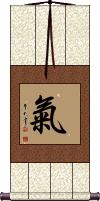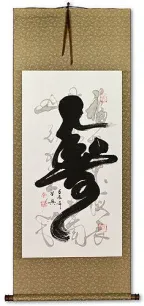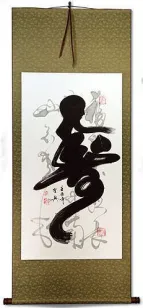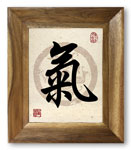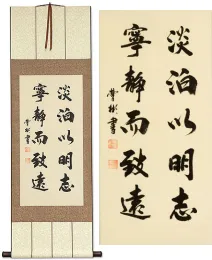Many custom options...
And formats...

Pure Life in Chinese / Japanese...
Buy a Pure Life calligraphy wall scroll here!
Personalize your custom “Pure Life” project by clicking the button next to your favorite “Pure Life” title below...
Clarity
清 is a word that means clarity or clear in Chinese, Japanese Kanji, and old Korean Hanja.
Looking at the parts of this character, you have three splashes of water on the left, “life” on the top right, and the moon on the lower right.
Because of something Confucius said about 2500 years ago, you can imagine that this character means “live life with clarity like bright moonlight piercing pure water.” The Confucian idea is something like “Keep clear what is pure in yourself, and let your pure nature show through.” Kind of like saying, “Don't pollute your mind or body, so that they remain clear.”
This might be stretching the definition of this single Chinese character but the elements are there, and “clarity” is a powerful idea.
Korean note: Korean pronunciation is given above but this character is written with a slight difference in the "moon radical" in Korean. However, anyone who can read Korean Hanja, will understand this character with no problem (this is considered an alternate form in Korean). If you want the more standard Korean Hanja form (which is an alternate form in Chinese), just let me know.
Japanese note: When reading in Japanese, this Kanji has additional meanings of pure, purify, or cleanse (sometimes to remove demons or "exorcise"). Used more in compound words in Japanese than as a stand-alone Kanji.
Life Energy / Spiritual Energy
Chi Energy: Essence of Life / Energy Flow
This 氣 energy flow is a fundamental concept of traditional Asian culture.
氣 is romanized as “Qi” or “Chi” in Chinese, “Gi” in Korean, and “Ki” in Japanese.
Chi is believed to be part of everything that exists, as in “life force” or “spiritual energy.” It is most often translated as “energy flow” or literally as “air” or “breath.” Some people will simply translate this as “spirit,” but you must consider the kind of spirit we're talking about. I think this is weighted more toward energy than spirit.
The character itself is a representation of steam (or breath) rising from rice. To clarify, the character for rice looks like this: ![]()
Steam was apparently seen as visual evidence of the release of “life energy” when this concept was first developed. The Qi / Chi / Ki character is still used in compound words to mean steam or vapor.
The etymology of this character is a bit complicated. It's suggested that the first form of this character from bronze script (about 2500 years ago) looked like these samples: 

However, it was easy to confuse this with the character for the number three. So the rice radical was added by 221 B.C. (the exact time of this change is debated). This first version with the rice radical looks like this: 
The idea of Qi / Chi / Ki is really a philosophical concept. It's often used to refer to the “flow” of metaphysical energy that sustains living beings. Yet there is much debate that has continued for thousands of years as to whether Qi / Chi / Ki is pure energy or consists partially or fully of matter.
You can also see the character for Qi / Chi / Ki in common compound words such as Tai Chi / Tai Qi, Aikido, Reiki, and Qi Gong / Chi Kung.
In the modern Japanese Kanji, the rice radical has been changed into two strokes that form an X.
![]() The original and traditional Chinese form is still understood in Japanese, but we can also offer that modern Kanji form in our custom calligraphy. If you want this Japanese Kanji, please click on the character to the right instead of the “Select and Customize” button above.
The original and traditional Chinese form is still understood in Japanese, but we can also offer that modern Kanji form in our custom calligraphy. If you want this Japanese Kanji, please click on the character to the right instead of the “Select and Customize” button above.
More language notes: This is pronounced like “chee” in Mandarin Chinese, and like “key” in Japanese.
This is also the same way to write this in Korean Hanja where it is Romanized as “gi” and pronounced like “gee” but with a real G-sound, not a J-sound.
Though Vietnamese no longer use Chinese characters in their daily language, this character is still widely known in Vietnam.
See Also: Energy | Life Force | Vitality | Life | Birth | Soul
This in-stock artwork might be what you are looking for, and ships right away...
Gallery Price: $61.00
Your Price: $33.88
Longevity / Long Life Unique Calligraphy Scroll
Discounted Blemished
Gallery Price: $47.00
Your Price: $26.00
Longevity / Long Life Calligraphy Wall Scroll
Discounted Blemished
Gallery Price: $63.00
Your Price: $35.00
Longevity / Long Life Calligraphy Wall Scroll
Discounted Blemished
Gallery Price: $31.00
Your Price: $17.00
Gallery Price: $61.00
Your Price: $33.88
Gallery Price: $61.00
Your Price: $33.88
Gallery Price: $61.00
Your Price: $33.88
Gallery Price: $61.00
Your Price: $33.88
Gallery Price: $61.00
Your Price: $33.88
Gallery Price: $61.00
Your Price: $33.88
Gallery Price: $61.00
Your Price: $33.88
Gallery Price: $198.00
Your Price: $109.88
Not the results for pure life that you were looking for?
Below are some entries from our dictionary that may match your pure life search...
| Characters If shown, 2nd row is Simp. Chinese |
Pronunciation Romanization |
Simple Dictionary Definition |
信 see styles |
xìn xin4 hsin shin しん |
More info & calligraphy: Honesty / Fidelity(1) honesty; sincerity; fidelity; (2) trust; reliance; confidence; (3) (religious) faith; devotion; (counter) (4) counter for received messages; (female given name) Yuki śraddhā. Faith; to believe; belief; faith regarded as the faculty of the mind which sees, appropriates, and trusts the things of religion; it joyfully trusts in the Buddha, in the pure virtue of the triratna and earthly and transcendental goodness; it is the cause of the pure life, and the solvent of doubt. Two forms are mentioned: (1) adhimukti, intuition, tr. by self-assured enlightenment. (2) śraddhā, faith through hearing or being taught. For the Awakening of Faith, Śraddhotpāda, v. 起信論. |
布施 see styles |
bù shī bu4 shi1 pu shih fuse ふせ |
More info & calligraphy: Dana: Almsgiving and Generosity(n,vs,vi) (1) {Buddh} alms-giving; charity; (n,vs,vi) (2) {Buddh} offerings (usu. money) to a priest (for reading sutras, etc.); (surname) Fuho dāna 檀那; the sixth pāramitā, almsgiving, i. e. of goods, or the doctrine, with resultant benefits now and also hereafter in the forms of reincarnation, as neglect or refusal will produce the opposite consequences. The 二種布施 two kinds of dāna are the pure, or unsullied charity, which looks for no reward here but only hereafter; and the sullied almsgiving whose object is personal benefit. The three kinds of dāna are goods, the doctrine, and courage, or fearlessness. The four kinds are pens to write the sutras, ink, the sutras themselves, and preaching. The five kinds are giving to those who have come from a distance, those who are going to a distance, the sick, the hungry, those wise in the doctrine. The seven kinds are giving to visitors, travellers, the sick, their nurses, monasteries, endowments for the sustenance of monks or nuns, and clothing and food according to season. The eight kinds are giving to those who come for aid, giving for fear (of evil), return for kindness received, anticipating gifts in return, continuing the parental example of giving, giving in hope of rebirth in a particular heaven, in hope of an honoured name, for the adornment of the heart and life. 倶舍論 18. |
永生 see styles |
yǒng shēng yong3 sheng1 yung sheng eisei / ese えいせい |
More info & calligraphy: Eternal Life / Everlasting Life / Immortalityeternal life; immortality; (personal name) Hisaki Eternal life; immortality; nirvana is defined as 不生 not being born, i. e. not reborn, and therefore 不滅 not dying; 永生 is also perpetual life; the Amitābha cult says in the Pure Land. |
塵 尘 see styles |
chén chen2 ch`en chen chiri ちり |
dust; dirt; earth (1) dust; (2) trash; garbage; rubbish; dirt; (3) (usu. as 塵ほども...ない) negligible amount; tiny bit; (4) hustle and bustle (of life); worldly cares; impurities of the world; (5) (abbreviation) {sumo} (See 塵手水) ritual gestures indicating that a fight will be clean guṇa, in Sanskrit inter alia means 'a secondary element', 'a quality', 'an attribute of the five elements', e.g. 'ether has śabda or sound for its guṇa and the ear for its organ'. In Chinese it means 'dust, small particles; molecules, atoms, exhalations'. It may be intp. as an atom, or matter, which is considered as defilement; or as an active, conditioned principle in nature, minute, subtle, and generally speaking defiling to pure mind; worldly, earthly, the world. The six guṇas or sensation-data are those of sight, sound, smell, taste, touch, and thought. |
下品 see styles |
xià pǐn xia4 pin3 hsia p`in hsia pin gehin げひん |
(noun or adjectival noun) vulgar; indecent; coarse; crude; (place-name) Shimoshina The three lowest of the nine classes born in the Amitābha Pure Land, v. 無量壽經. These three lowest grades are (1) 下品上生 The highest of the three lowest classes who enter the Pure Land of Amitābha, i.e. those who have committed all sins except dishonouring the sūtras. If at the end of life the sinner clasps hands and says "Namo Amitābha", such a one will be born in His precious lake. (2) 下品中生 The middle class consists of those who have broken all the commandments, even stolen from monks and abused the law. If at death such a one hears of the great power of Amitābha, and assents with but a thought, he will be received into paradise. (3) 下品下生 The lowest class, because of their sins, should have fallen into the lowest gati, but by invoking the name of Amitābha, they can escape countless ages of reincarnation and suffering and on dying will behold a lotus flower like the sun, and, by the response of a single thought, will enter the Pure Land of Amitābha. |
九地 see styles |
jiǔ dì jiu3 di4 chiu ti kyuuchi / kyuchi きゅうち |
very low land; (surname) Kuji The nine lands, i.e. the 欲界 realm of desire or sensuous realm the four 色界 realms of form or material forms; and the four 無色界 formless realms, or realms beyond form; v. 九有, 九有情居, 禪 and 定. The nine realms are:—(1) 欲界五趣地; the desire realm with its five gati, i.e. hells, hungry ghosts, animals, men, and devas. In the four form-realms are:— (2) 離生喜樂地 Paradise after earthly life, this is also the first dhyāna, or subject of meditation, 初禪. (3) 定生喜樂地 Paradise of cessation of rebirth, 二禪. (4) 離喜妙樂地 Land of wondrous joy after the previous joys, 三禪. (5) 捨念淸淨地 The Pure Land of abandonment of thought, or recollection (of past delights), 四禪. The four formless, or infinite realms, catur arūpa dhātu, are:—(6) 空無邊處地 ākāśānantyā-yatanam, the land of infinite space; also the first samādhi, 第一定. (7) 識無邊處地 vijñānānamtyāyatanam, the land of omniscience, or infinite perception, 二定. (8) 無所有處地 ākiñcanyāyatana, the land of nothingness, 三定. (9) 非想非非想處地 naivasaṁjñānā-saṁjñāyatana, the land (of knowledge) without thinking or not thinking, or where there is neither consciousness nor unconsciousness, i.e. above either; this is the 四定. Eitel says that in the last four, "Life lasts 20,000 great kalpas in the 1st, 40,000 in the 2nd, 60,000 in the 3rd, and 80,000 great kalpas in the 4th of these heavens." |
利人 see styles |
lì rén li4 ren2 li jen rihito りひと |
(given name) Rihito To benefit or profit men, idem利他 parahita; the bodhisattva-mind is 自利利他 to improve oneself for the purpose of improving or benefiting others; the Buddha-mind is 利他一心 with single mind to help others, pure altruism; 利生 is the extension of this idea to 衆生 all the living, which of course is not limited to men or this earthly life; 利物 is also used with the same meaning, 物 being the living. |
四法 see styles |
sì fǎ si4 fa3 ssu fa shihō |
There are several groups of four dharma: (1) 教法 the teaching of the Buddha); 理法 its principles, or meaning; 行法 its practice; 果法 its fruits or rewards. (2) Another group relates to bodhisattvas, their never losing the bodhi-mind, or the wisdom attained, or perseverance in progress, or the monastic forest life (āraṇyaka). (3) Also 信解行證 faith, discernment, performance, and assurance. (4) The Pure-land 'True' sect of Japan has a division: 教法, i. e. the 大無量壽經; 行法 the practice of the seventeenth of Amitābha's vows; 信法 faith in the eighteenth; and 證法 proof of the eleventh. The most important work of Shinran, the founder of the sect, is these four, i. e. 教行信證. (5) A 'Lotus ' division of 四法 is the answer to a question of Puxian (Samantabhadra) how the Lotus is to be possessed after the Buddha's demise, i. e. by thought (or protection) of the Buddhas; the cultivation of virtue; entry into correct dhyāna; and having a mind to save all creatures. |
往生 see styles |
wǎng shēng wang3 sheng1 wang sheng oujou / ojo おうじょう |
to be reborn; to live in paradise (Buddhism); to die; (after) one's death (n,vs,vi) (1) {Buddh} passing on to the next life; (n,vs,vi) (2) death; (n,vs,vi) (3) giving up a struggle; submission; (n,vs,vi) (4) being at one's wits' end; being flummoxed; (5) (rare) (See 圧状・2) coercion The future life, the life to which anyone is going; to go to be born in the Pure Land of Amitābha. (1) 往相囘向 To transfer one's merits to all beings that they may attain the Pure Land of Amitābha. (2) 還相囘向 Having been born in the Pure Land to return to mortality and by one's merits to bring mortals to the Pure Land. |
淨命 净命 see styles |
jìng mìng jing4 ming4 ching ming jōmyō |
Pure livelihood, 正命, i.e. that of the monk. Also the life of a pure or unperturbed mind. |
清恬 see styles |
qīng tián qing1 tian2 ch`ing t`ien ching tien |
pure and quiet (of life); tranquil and comfortable |
生死 see styles |
shēng sǐ sheng1 si3 sheng ssu seishi(p); shouji; shoushi / seshi(p); shoji; shoshi せいし(P); しょうじ; しょうし |
life or death (1) life and death; life or death; (2) (しょうじ, しょうし only) {Buddh} samsara (cycle of death and rebirth); (3) (しょうじ, しょうし only) death saṃsāra: birth and death: rebirth and redeath; life and death; 生死, 死生; 生生死死 ever-recurring saṃsāra or transmigrations; the round of mortality. There are two, three, four, seven, and twelve kinds of 生死; the two are 分斷生死 the various karmaic transmigrations, and 不思義變易生死 (or simply 變易生死) the inconceivable transformation life in the Pure Land. Among the twelve are final separation from mortality of the arhat, with 無餘 no remains of it causing return; one final death and no rebirth of the anāgāmin; the seven advancing rebirths of the srota-āpanna; down to the births-cum-deaths of hungry ghosts. |
白報 白报 see styles |
bái bào bai2 bao4 pai pao byappō |
Pure reward, or the reward of a good life. |
兜率陀 see styles |
dōu shuài tuó dou1 shuai4 tuo2 tou shuai t`o tou shuai to Tosotsuda |
(兜率 or 兜率哆); 兜術; 珊都史多, 珊覩史多; 鬭瑟多 Tuṣita, from tuṣ, contented, satisfied, gratified; name of the Tuṣita heaven, the fourth devaloka in the 欲界 passion realm, or desire realm between the Yama and Nirmāṇarati heavens. Its inner department is the Pure Land of Maitreya who, like Śākyamuni and all Buddhas, is reborn there before descending to earth as the next Buddha; his life there is 4,000 Tuṣita years (each day there being equal to 4000 earth-years) 584 million such years. |
婆羅門 婆罗门 see styles |
pó luó mén po2 luo2 men2 p`o lo men po lo men baramon; baramon; buraaman / baramon; baramon; buraman ばらもん; バラモン; ブラーマン |
Brahmin (noun - becomes adjective with の) (1) (kana only) Brahman (priest of Hinduism, members of the highest caste) (san: brahmana); (noun - becomes adjective with の) (2) Brahmanism; priest of Brahmanism 跋濫摩; 沒囉憾摩 Brāhmaṇa; Brāhmanical; Brāhman; 淨行; 婆志 of pure life or mind; the highest of the four castes, those who serve Brahma, his offspring, the keepers of the Vedas. |
贈五重 赠五重 see styles |
zèng wǔ chóng zeng4 wu3 chong2 tseng wu ch`ung tseng wu chung sō gojū |
A service of the Pure-land sect, consisting of five esoteric rituals, for admitting the deceased into the lineage of the Buddha to ensure his welfare in the next life. |
阿彌陀 阿弥陀 see styles |
ā mí tuó a1 mi2 tuo2 a mi t`o a mi to Amida あみだ |
(out-dated kanji) (1) (Buddhist term) Amitabha (Buddha); Amida; (2) (kana only) (abbreviation) ghostleg lottery; ladder lottery; lottery in which participants trace a line across a lattice pattern to determine the winner; (3) (kana only) (abbreviation) wearing a hat pushed back on one's head (阿彌) amita, boundless, infinite; tr. by 無量 immeasurable. The Buddha of infinite qualities, known as 阿彌陀婆 (or 阿彌陀佛) Amitābha, tr. 無量光 boundless light; 阿彌陀廋斯Amitāyus, tr. 無量壽 boundless age, or life; and among the esoteric sects Amṛta 甘露 (甘露王) sweet-dew (king). An imaginary being unknown to ancient Buddhism, possibly of Persian or Iranian origin, who has eclipsed the historical Buddha in becoming the most popular divinity in the Mahāyāna pantheon. His name indicates an idealization rather than an historic personality, the idea of eternal light and life. The origin and date of the concept are unknown, but he has always been associated with the west, where in his Paradise, Suikhāvatī, the Western Pure Land, he receives to unbounded happiness all who call upon his name (cf. the Pure Lands 淨土 of Maitreya and Akṣobhya). This is consequent on his forty-eight vows, especially the eighteenth, in which he vows to refuse Buddhahood until he has saved all living beings to his Paradise, except those who had committed the five unpardonable sins, or were guilty of blasphemy against the Faith. While his Paradise is theoretically only a stage on the way to rebirth in the final joys of nirvana, it is popularly considered as the final resting-place of those who cry na-mo a-mi-to-fo, or blessed be, or adoration to, Amita Buddha. The 淨土 Pure-land (Jap. Jōdo) sect is especially devoted to this cult, which arises chiefly out of the Sukhāvatīvyūha, but Amita is referred to in many other texts and recognized, with differing interpretations and emphasis, by the other sects. Eitel attributes the first preaching of the dogma to 'a priest from Tokhara' in A. D.147, and says that Faxian and Xuanzang make no mention of the cult. But the Chinese pilgrim 慧日Huiri says he found it prevalent in India 702-719. The first translation of the Amitāyus Sutra, circa A.D. 223-253, had disappeared when the Kaiyuan catalogue was compiled A.D. 730. The eighteenth vow occurs in the tr. by Dharmarakṣa A.D. 308. With Amita is closely associated Avalokiteśvara, who is also considered as his incarnation, and appears crowned with, or bearing the image of Amita. In the trinity of Amita, Avalokiteśvara appears on his left and Mahāsthāmaprāpta on his right. Another group, of five, includes Kṣitigarbha and Nāgārjuna, the latter counted as the second patriarch of the Pure Land sect. One who calls on the name of Amitābha is styled 阿彌陀聖 a saint of Amitābha. Amitābha is one of the Five 'dhyāni buddhas' 五佛, q.v. He has many titles, amongst which are the following twelve relating to him as Buddha of light, also his title of eternal life: 無量光佛Buddha of boundless light; 無邊光佛 Buddha of unlimited light; 無礙光佛 Buddha of irresistible light; 無對光佛 Buddha of incomparable light; 燄王光佛 Buddha of yama or flame-king light; 淸淨光佛 Buddha of pure light; 歡喜光佛 Buddha of joyous light; 智慧光佛 Buddha of wisdom light; 不斷光佛 Buddha of unending light; 難思光佛 Buddha of inconceivable light; 無稱光佛Buddha of indescribable light; 超日月光佛 Buddha of light surpassing that of sun and moon; 無量壽 Buddha of boundless age. As buddha he has, of course, all the attributes of a buddha, including the trikāya, or 法報化身, about which in re Amita there are differences of opinion in the various schools. His esoteric germ-letter is hrīḥ, and he has specific manual-signs. Cf. 阿彌陀經, of which with commentaries there are numerous editions. |
一九之生 see styles |
yī jiǔ zhī shēng yi1 jiu3 zhi1 sheng1 i chiu chih sheng ikku no shō |
Future life in the Amitābha Pure Land. |
九品往生 see styles |
jiǔ pǐn wǎng shēng jiu3 pin3 wang3 sheng1 chiu p`in wang sheng chiu pin wang sheng kuhon ōjō |
The ninefold future life, in the Pure Land, v. 九品淨土. It is detailed in the sutra of this name whose full title is 阿彌陀三摩地集陀羅尼經. |
九品淨土 九品净土 see styles |
jiǔ pǐn jìng tǔ jiu3 pin3 jing4 tu3 chiu p`in ching t`u chiu pin ching tu kuhon jōdo |
also 九品淨刹 , 九品安養, 九品蓮臺, 九品往生 The nine grades, or rewards, of the Pure Land, corresponding to the nine grades of development in the previous life, upon which depends, in the next life, one's distance from Amitābha, the consequent aeons that are needed to approach him, and whether one's lotus will open early or late. |
淸淨覺海 淸淨觉海 see styles |
qīng jìng jué hǎi qing1 jing4 jue2 hai3 ch`ing ching chüeh hai ching ching chüeh hai shōjō kaku kai |
The pure ocean of enlightenment, which underlies the disturbed life of all. |
狂亂往生 狂乱往生 see styles |
kuáng luàn wǎng shēng kuang2 luan4 wang3 sheng1 k`uang luan wang sheng kuang luan wang sheng kyōran ōjō |
Saved out of terror into the next life; however distressed by thoughts of hell as the result of past evil life, ten repetitions, or even one, of the name of Amitābha ensures entry into his Paradise. |
已今當往生 已今当往生 see styles |
yǐ jīn dāng wǎng shēng yi3 jin1 dang1 wang3 sheng1 i chin tang wang sheng ikintō ōjō |
Those born into the 'future life, ' (of the Pure Land) in the past, in the present, and to be born in the future. |
觀無量壽經 观无量寿经 see styles |
guān wú liáng shòu jīng guan1 wu2 liang2 shou4 jing1 kuan wu liang shou ching Kammuryōju kyō |
An important sūtra relating to Amitayus' or Amitābha, and his Pure Land, known also as 佛說觀無量壽佛經. There are numerous commentaries on it. The title is commonly abbreviated to 觀經. |
The following table may be helpful for those studying Chinese or Japanese...
| Title | Characters | Romaji (Romanized Japanese) | Various forms of Romanized Chinese | |
| Clarity | 清 | sei | qīng / qing1 / qing | ch`ing / ching |
| Life Energy Spiritual Energy | 氣 气 / 気 | ki | qì / qi4 / qi | ch`i / chi |
| In some entries above you will see that characters have different versions above and below a line. In these cases, the characters above the line are Traditional Chinese, while the ones below are Simplified Chinese. | ||||
Successful Chinese Character and Japanese Kanji calligraphy searches within the last few hours...

